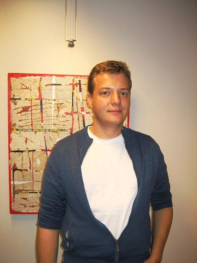Nanofabrication methods for improved bone implants
Promotion date: 2. september 2011
Promotor: Prof. dr. Han Gardeniers
Co-promotor: Dr. Regina Luttge
| The hypothesis of this thesis, is that nanofeatures on the surface of an implant enhance bio-functionality. This work introduces several approaches to micro- and nano-patterning which are well-known in the MEMS and NEMS fields. Micro- and nano-engineering of materials like ceramics, polymers, silicon and titanium are presented. The work was part of the STW project NanoSurf. Further, a novel nanofabrication method for ridges and grooves on biomaterials delivered highly ordered nanoscale patterns. To obtain nanofeatures on biomaterial surfaces, first Laser Interference Lithography was employed to define patterns in resist on silicon. Next the structures were transferred into silicon with multiple reactive ion etching (RIE) steps. Finally the surface features were reproduced into polymers and used for in vitro studies or copied by means of Nanoimprint lithography (NIL) onto biomedical grade titanium and etched with an optimized chlorinated plasma reactive ion etching (RIE) process. In the biological research the nanofabricated surfaces were explored in interaction with ECM proteins. Finally the nanostructures were replicated in polystyrene slabs and a series of experiments with osteoblasts was performed, showing characteristic reactions of cells on distinct surface features. |
Is working on dental research a new expertise area at the University of Twente?
The Mesoscale Chemical Systems (MCS) group collaborated with the University of Nijmegen on this one, bringing in expertise concerning dental research. Using micro- and nanomachining and fabrication techniques, it is possible to use silicon as a platform for polymer and bio-research. Also titanium implants can be structured at a nano level in such a way that the body interacts with the implants in a new fashion, triggering responses (like protein expression or avoiding inflammatory effects), even steer them in the desired direction.
I started the topic from scratch. In the beginning a lot of methods were available and looked attractive. The ultimate choice of techniques was one of intuition and convenience.
I stuck to this original choice and it turned out to be the right direction. As a final conclusion it can be said that the set of optimized fabrication routes presented here, provides well-defined modified biomaterial surfaces very suitable for parametric studies and further statistical research in implantology.
Did you manage to have some nice publications?
The Biomaterials, Nanomedicine were among the magazines we have published in. A patent was one of the results of our work. We are also thinking of utilizing the ideas into a spinoff company.
Are you a different type of scientist and researcher as your remember yourself four years ago?
As a matter of fact, I am a completely different person now. I started quite naively, very eager to deliver short term results. Now I know that making serious scientific contributions asks for systematic research aimed towards describing the whole process in great detail.
What are your future plans?
Being more of an experimentalist, I now like to learn about the non-academic world too. I cannot wait to see the other side of the process, the implementation of academic results in real-world systems.
In this period of my life I am curious how researchers perform in industry. Perhaps in a later stage I return to the academic world, who knows. Right now I am willing to change, not making a definite choice yet.
In august I am going to work in Munich, for the company Beckman Coulter, one of the world’s key producers of analytic medical equipment used in hospitals. The topic I am going to work on involves microfluidics.
I still hope to deliver some good results in a short time and also to use the expertise gained here at Mesa+. I even think some of the specialized equipment of Mesa+ might be of great value for some of the company’s R&D topics.
What, in your opinion, is important for Mesa+ to stay successful in future?
It is a good thing if PhD’s are able to learn about all possibilities of research and equipment in an early stage of their thesis project. In that way they can get the feeling of being able to use world’s leading methods of today’s science in nanotechnology, not narrowing their aims and possibilities beforehand. In that way they get a broader look as a self-standing scientist, making new connections, jumping over disciplines. Combining for example biology & nano, medicine & nano and electronics & biology.

